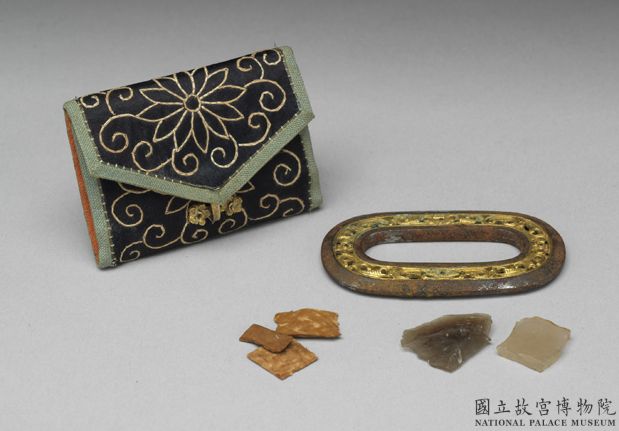Embroidered floral flint bag (with flint, striker, lacquer case, brocade, a note by Gaozong in Manchu and Chinese, sandalwood box), Empress Xiaoxian (1712-1748), Qing dynasty
- Image Number: K1J000225N000000000PAI
- Dynasty: Qing dynasty
- Category: Tapestries and embroideries
- Function: Container
- Material: Fabrics//
- Description:
Since the founding of the People’s Republic of China in the Qing Dynasty, the Manchu tradition has always been emphasized. This fire sickle purse has a three fold style, one fold in the middle with a sandwich, one end with a silver hook inside, and one end with a square Ruyi pattern hinge. The face is sewn with a flower shaped buckle, which can be buckled after folding. The inner layer has two sandwich bags with flint and wormwood inside. The fire sickle stored in the purse is a steel oblong circular ring, which is inlaid with ribbon shaped copper gilded hollowed out flowers. It is different from the shape of the common sickle back (or crescent shaped, axe shaped). There are two pieces of fire stones, which are irregular in shape, sharp in edge, hard and slightly transparent. The main component is quartz (silica), which is taken from hard mountain stones or river stones. The purse is upholstered in leather, covered with dark blue silk cloth, and the edge is inlaid with grey blue brocade cloth. Silver thread is nailed along the inner side of the cloth edge. The surface is especially embroidered with deer tail fine hair. The staple embroidery techniques commonly used by nomadic peoples such as Liao and Jin Dynasties are used for flower twig decoration. The flower pattern echoes the pattern on the fire sickle. The inner layer is lined with fine linen dyed red, which is very fine both in workmanship and embroidery. The inner layer of the purse left a mark and burn mark in the shape of a fire sickle, and the corresponding position of the fire sickle was also stained with cloth marks. It can be seen that the fire sickle and the purse were actually used by the emperor on weekdays. According to the wooden box inscriptions (also found in Volume 4 of the Second Collection of Imperial Poems), as Emperor Gaozong learned from the Qing Wen Jian that the Manchu people used deer tail hair as thread, Mulan and Empress Fucha (1712-1748) mentioned this in the 12th year of Qianlong’s reign (1747) in the autumn, when the Empress Xiaoxianchun and Empress Mulan made this authentic Manchu style fire sickle purse. In the year of Wuchen (the 13th year of Qianlong’s reign, 1748), Emperor Gaozong looked at the purse and recalled the queen who had just passed away. He had mixed feelings, so he made wooden boxes to hold the fire sickle purse and wrote poems and articles to express his ambition. Empress Gao Zongxiao, virtuous and pure was conferred the title of the direct blessing of Prince Bao Hongli in the fifth year of Emperor Yongzheng (1730), and later in the second year of Emperor Qianlong (1737). She was born in Manchuria with a yellow flag. She has a distinguished life experience and deep feelings between the husband and the wife. In addition to showing the empress’s virtue, this purse mentioned in the poem that “dress training, clothing, and hearing about the ancient times, and earth wall Ge Deng, don’t forget about the past. Let’s think together and show frugality, that is, we know we should be allowed to be virtuous.” It can also be seen that the imperial family of the Qing Dynasty attached great importance to the tradition of Manchu frugality and virtue, and reminded each other from time to time. In the artistic taste of the Qianlong Palace, Manchu’s various characteristics have always been an unforgettable focus.

![图片[2]-Embroidered floral flint bag (with flint, striker, lacquer case, brocade, a note by Gaozong in Manchu and Chinese, sandalwood box), Empress Xiaoxian (1712-1748), Qing dynasty-China Archive](https://chinaarchive.net/Qing dynasty/Tapestries and embroideries/K1J000225N000000000PAI-97095.jpg)
![图片[3]-Embroidered floral flint bag (with flint, striker, lacquer case, brocade, a note by Gaozong in Manchu and Chinese, sandalwood box), Empress Xiaoxian (1712-1748), Qing dynasty-China Archive](https://chinaarchive.net/Qing dynasty/Tapestries and embroideries/K1J000225N000000000PAI-97096.jpg)
![图片[4]-Embroidered floral flint bag (with flint, striker, lacquer case, brocade, a note by Gaozong in Manchu and Chinese, sandalwood box), Empress Xiaoxian (1712-1748), Qing dynasty-China Archive](https://chinaarchive.net/Qing dynasty/Tapestries and embroideries/K1J000225N000000000PAI-97097.jpg)
Pictures & Images [HD] download
© Copyright
The copyright of the article belongs to the author, please keep the original link for reprinting.
THE END





